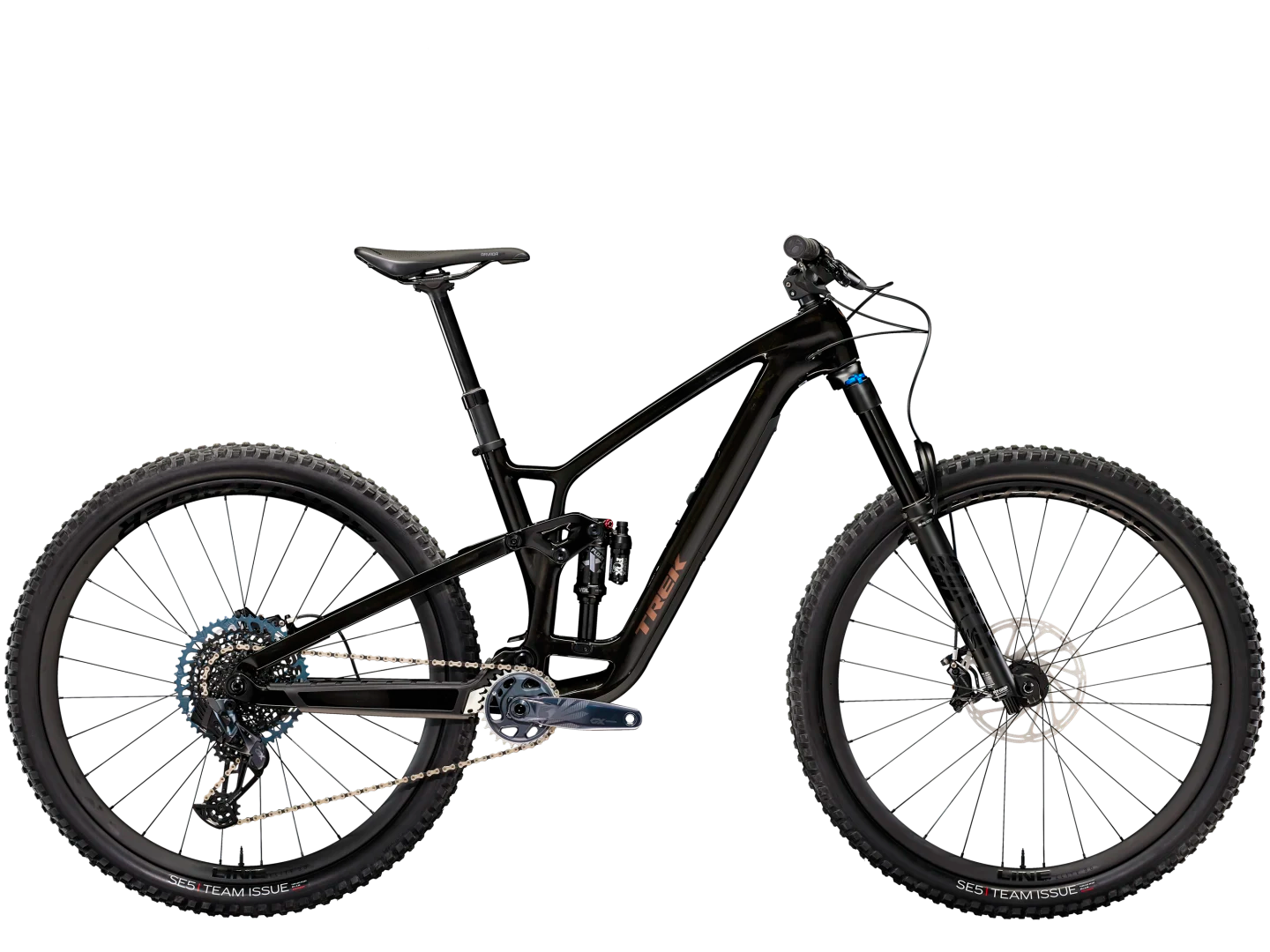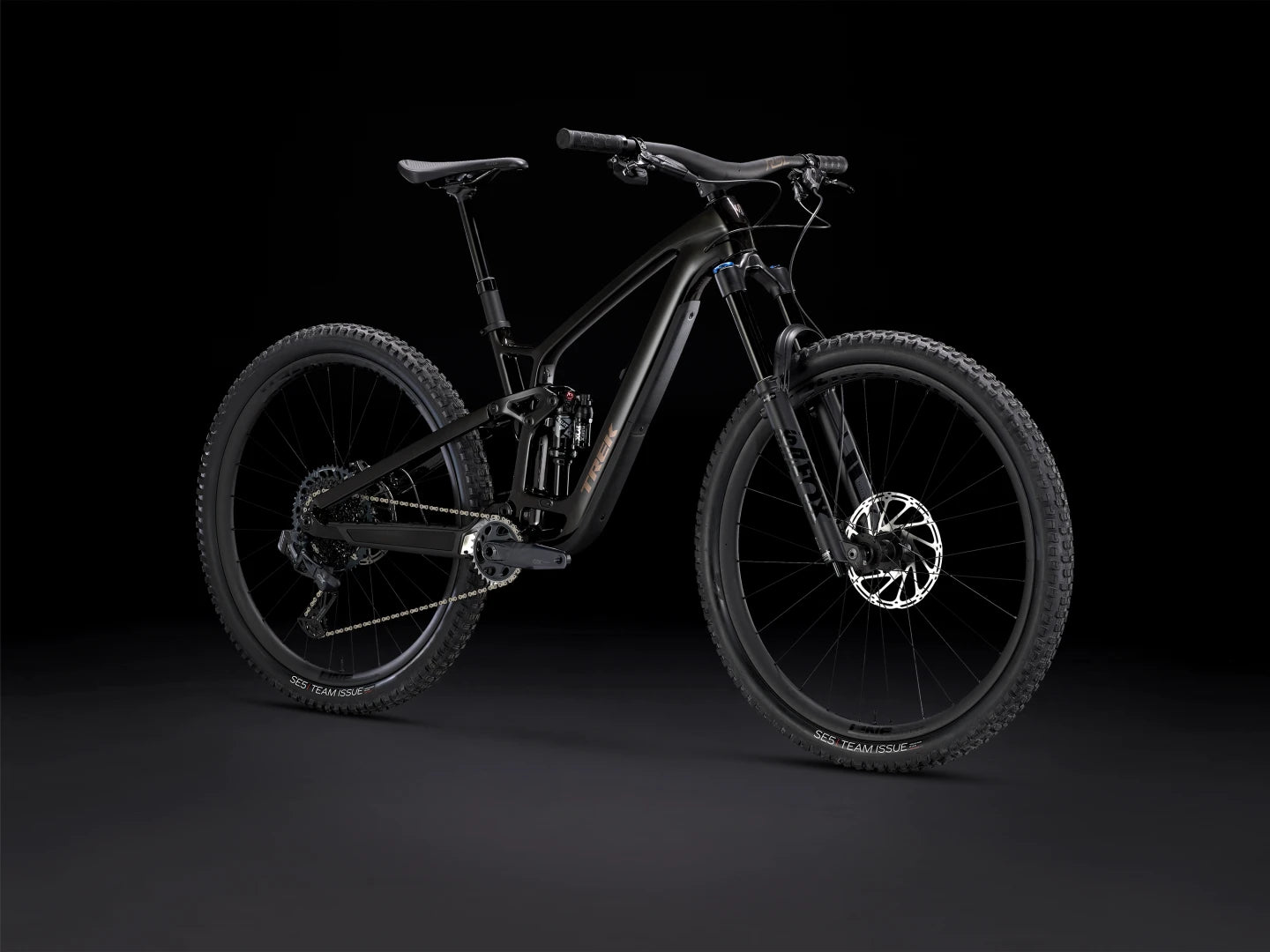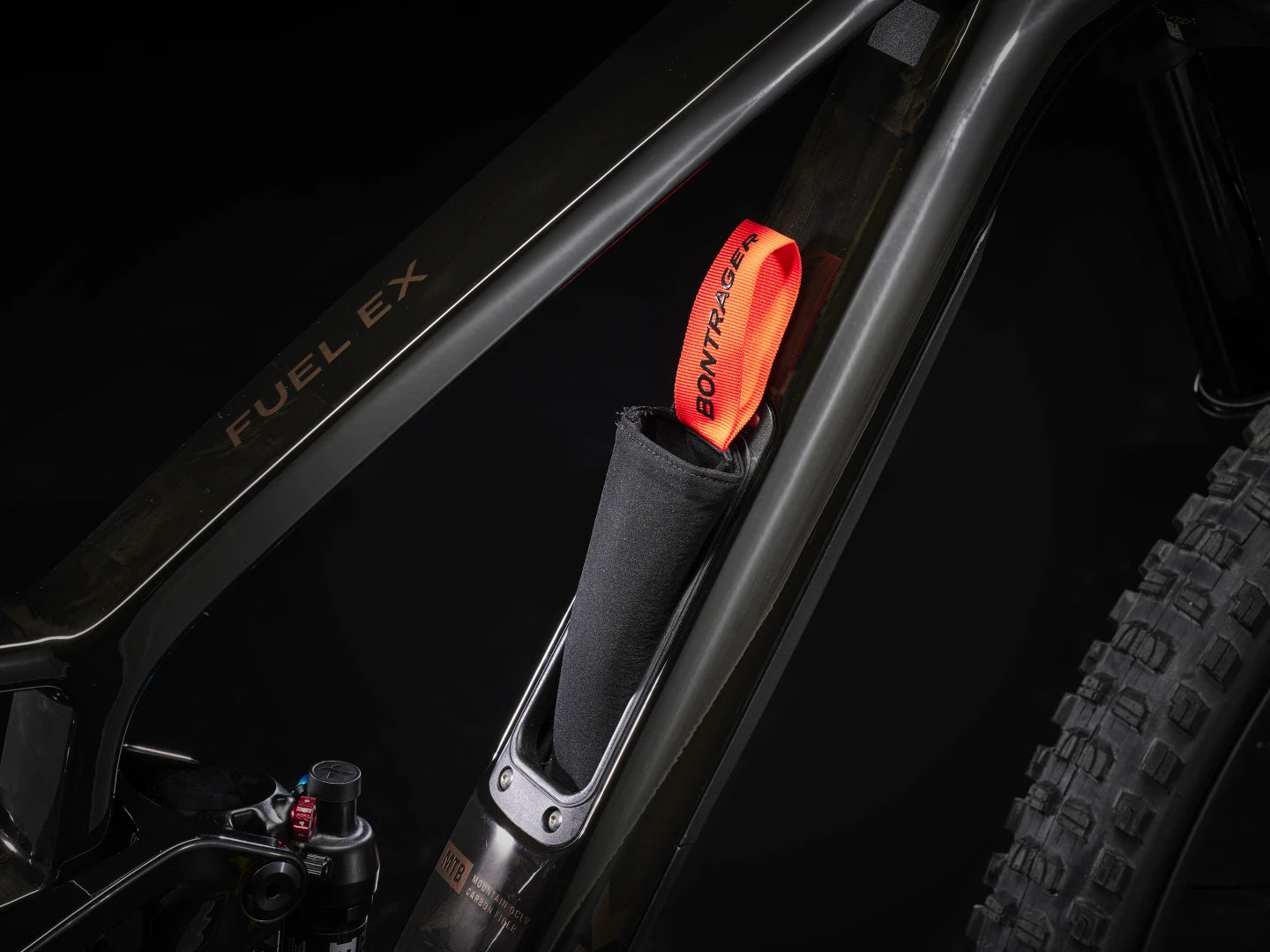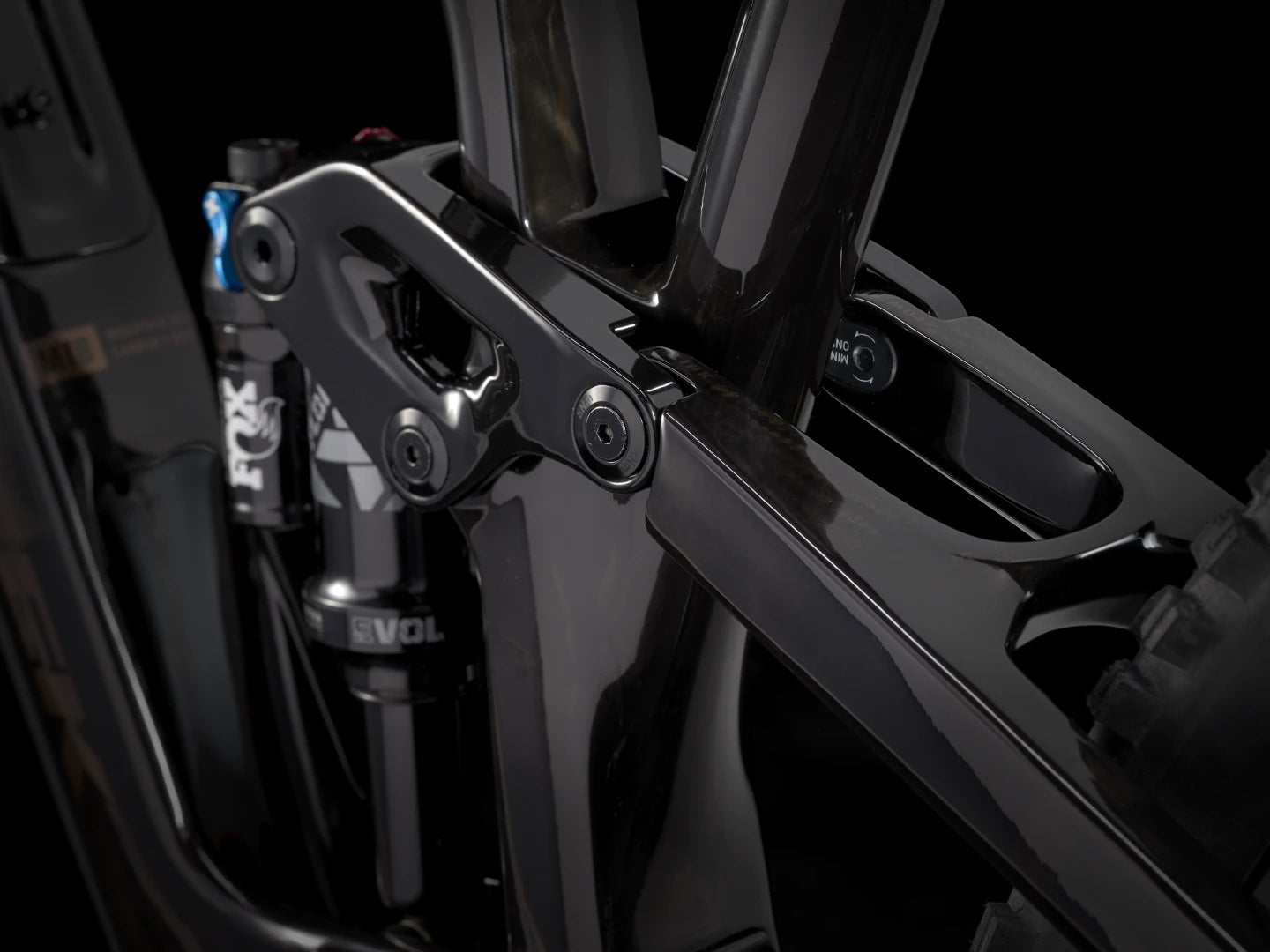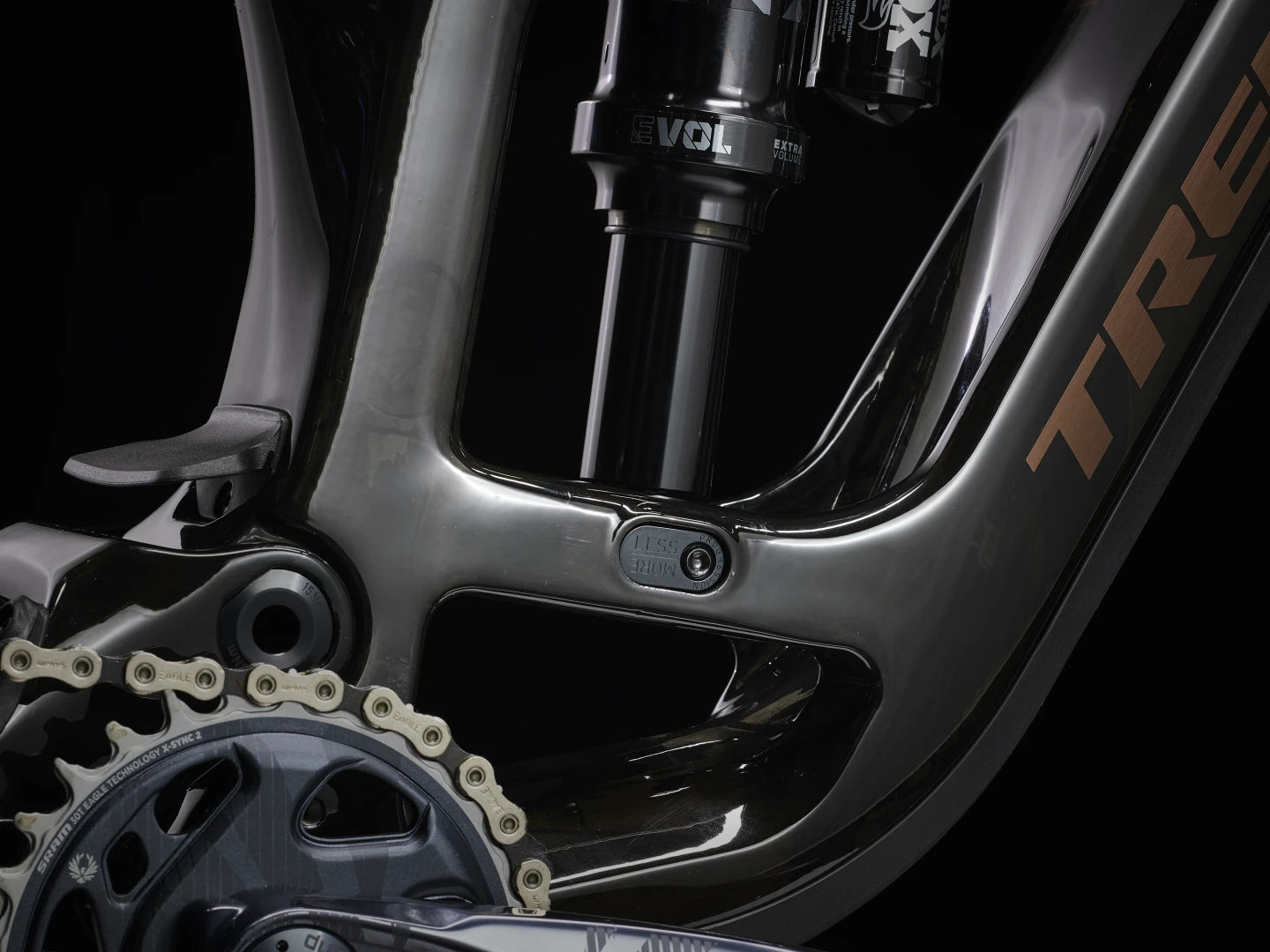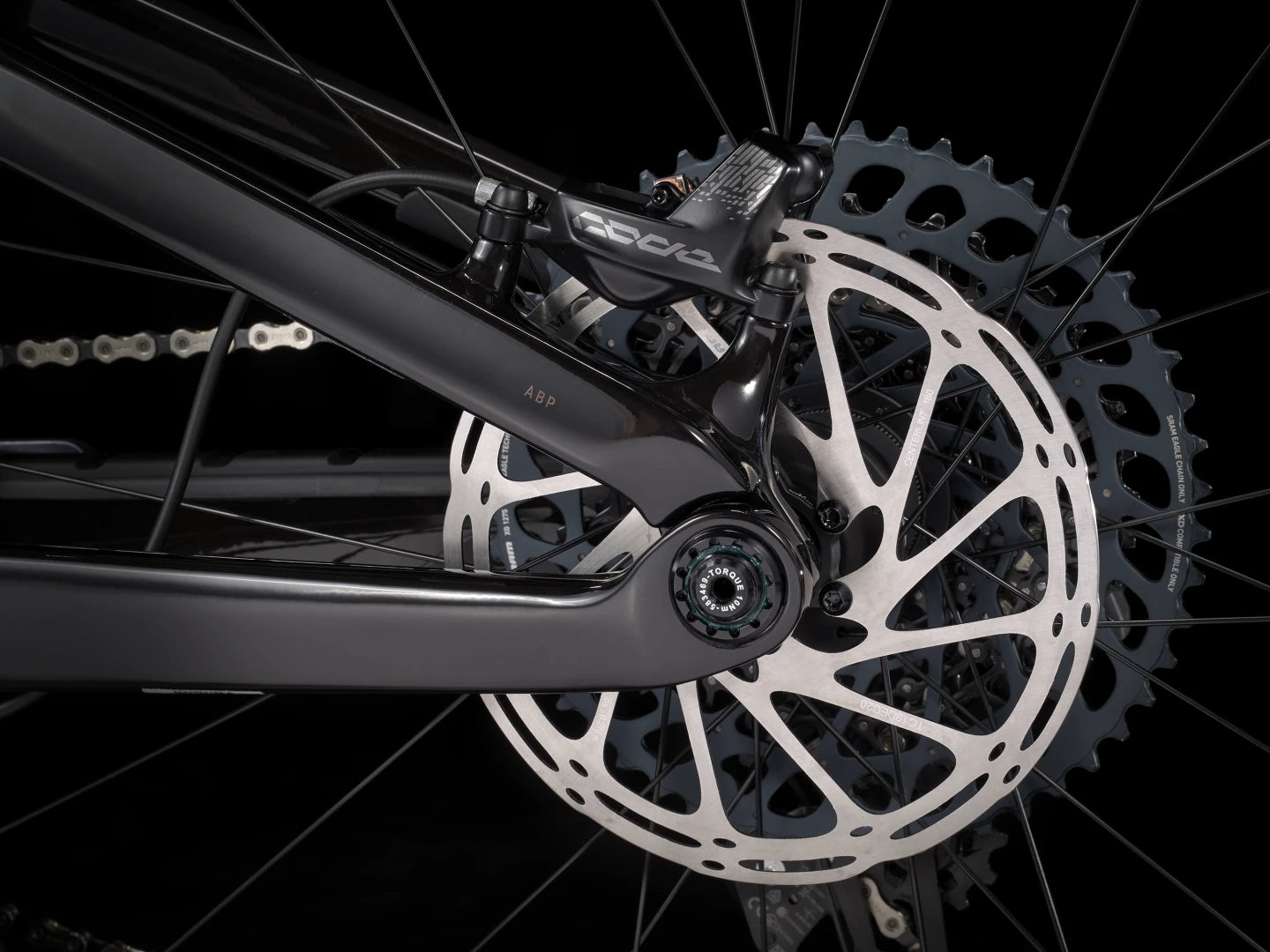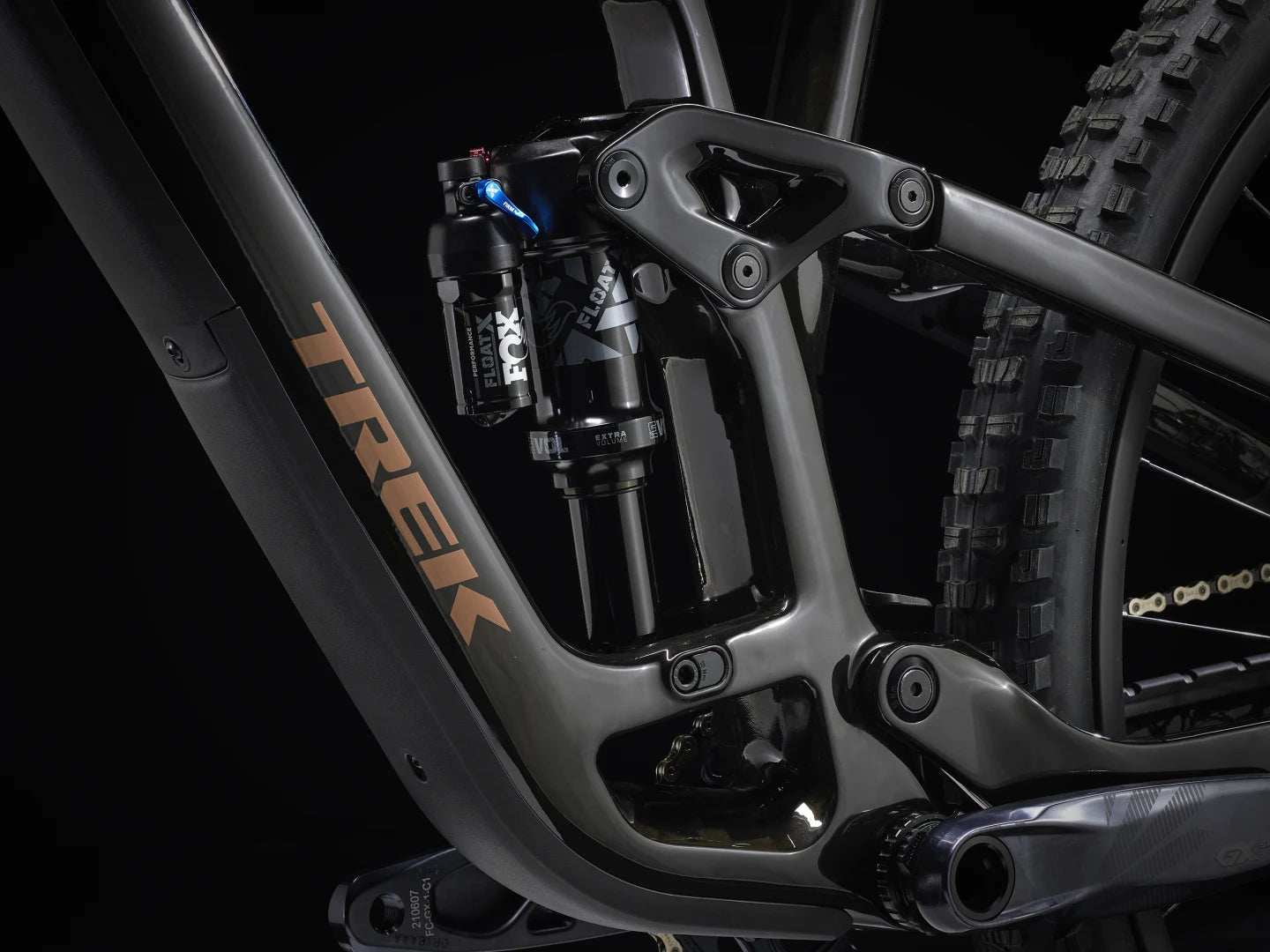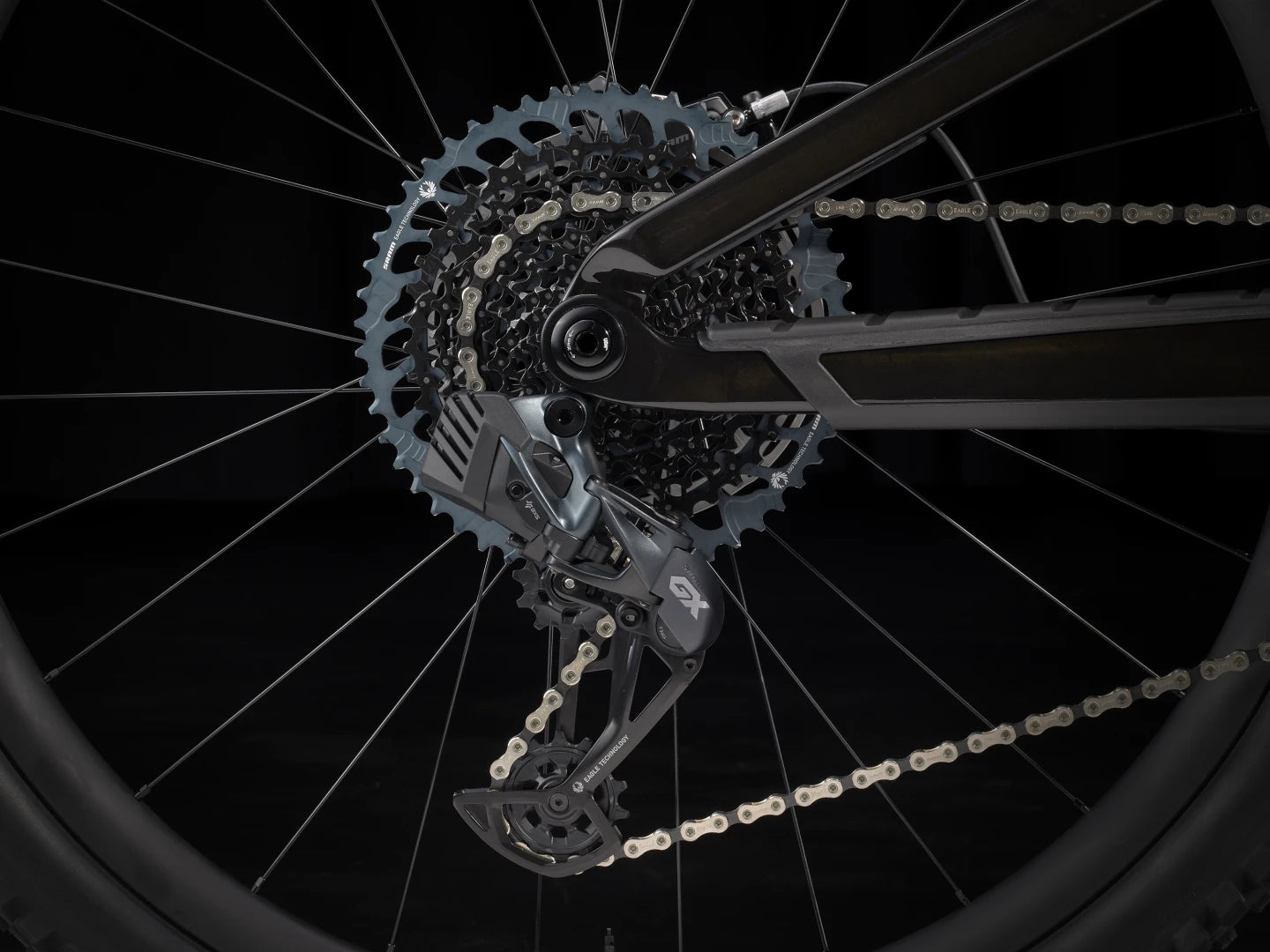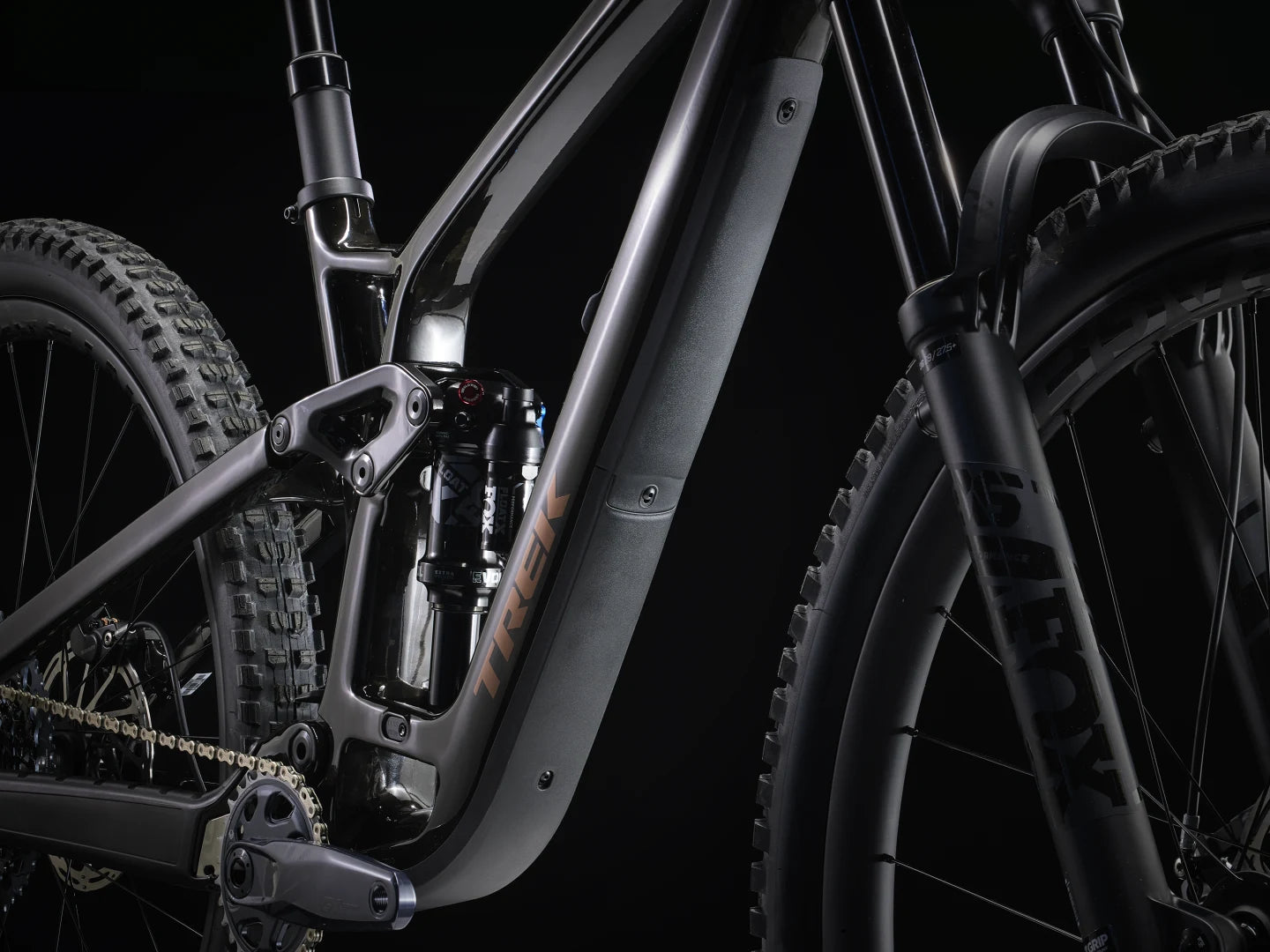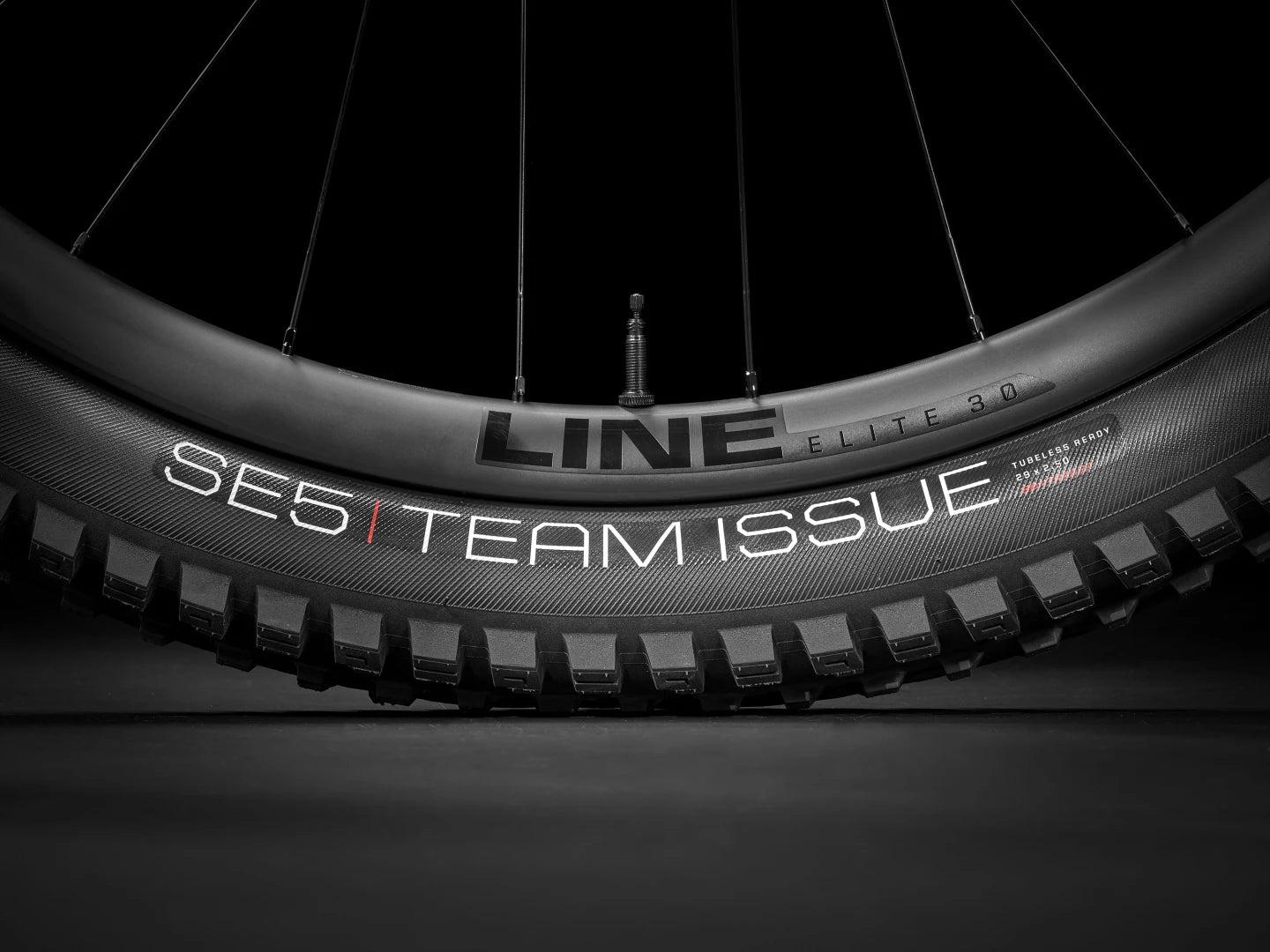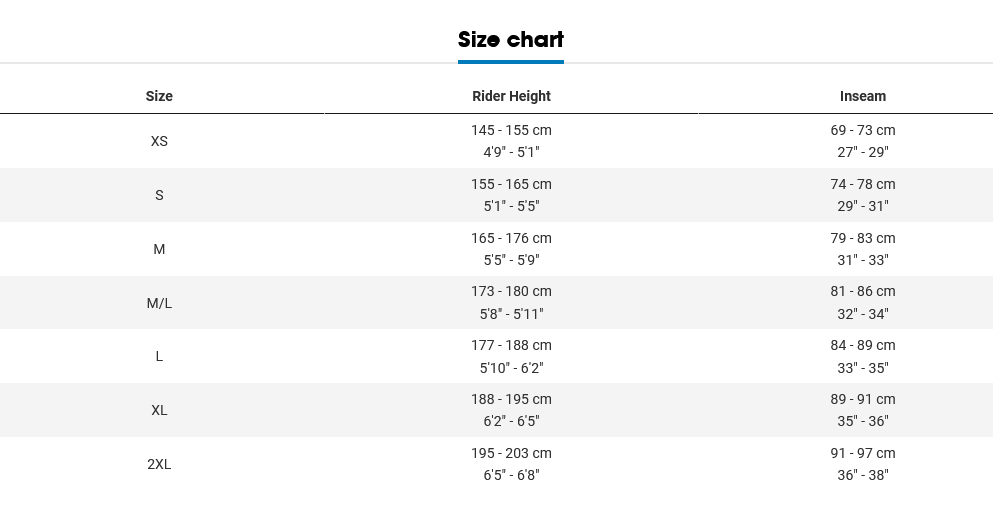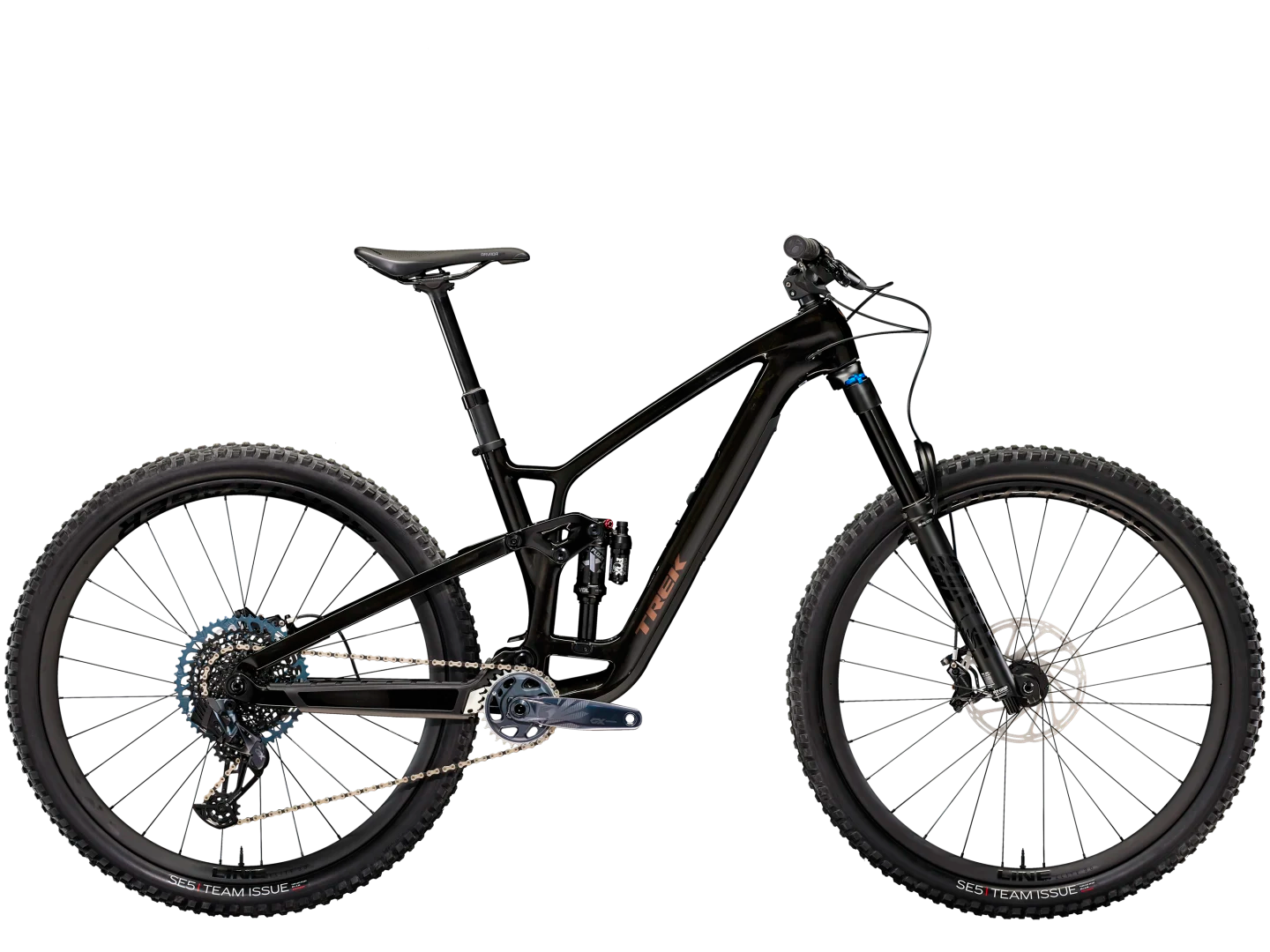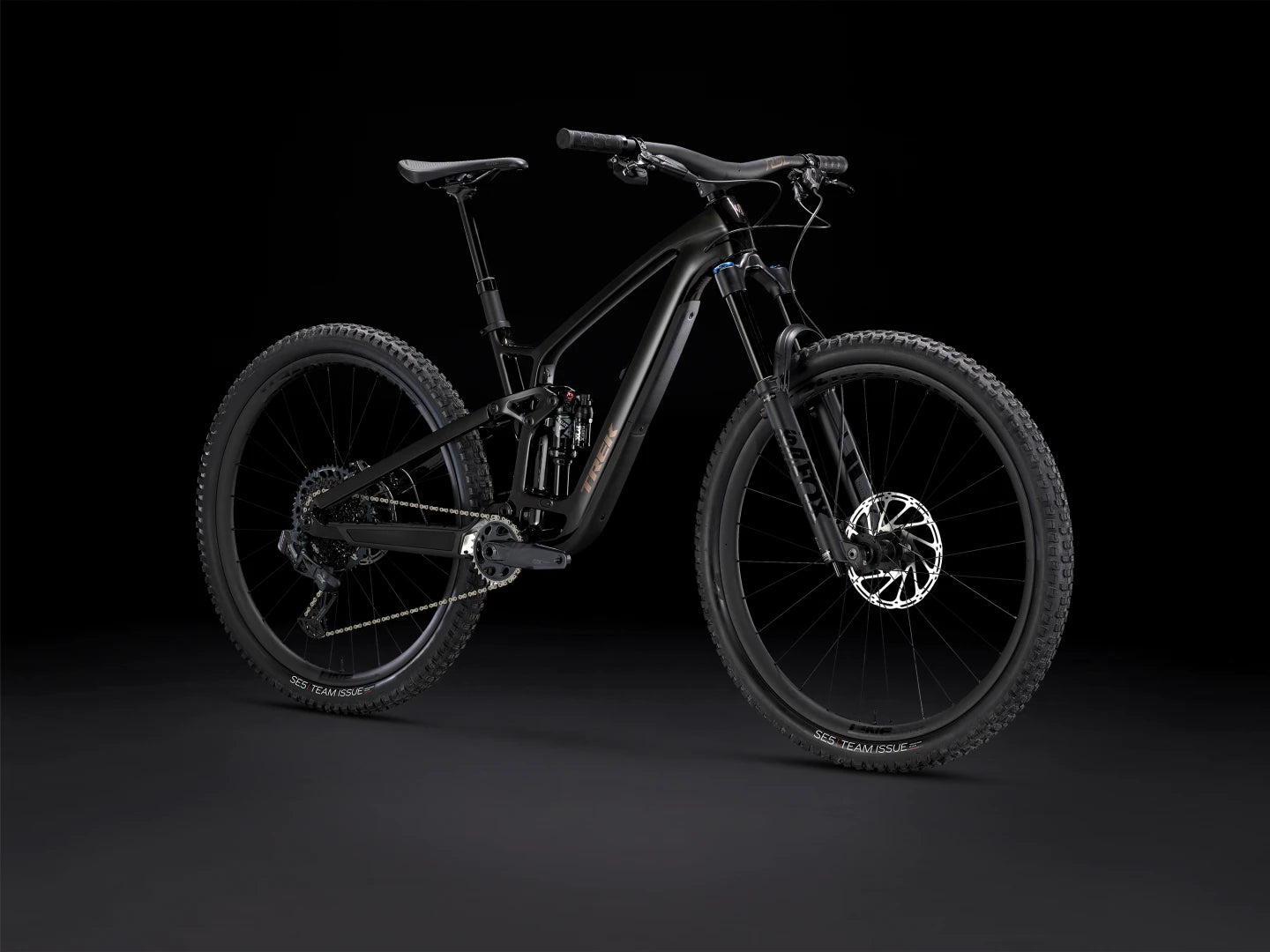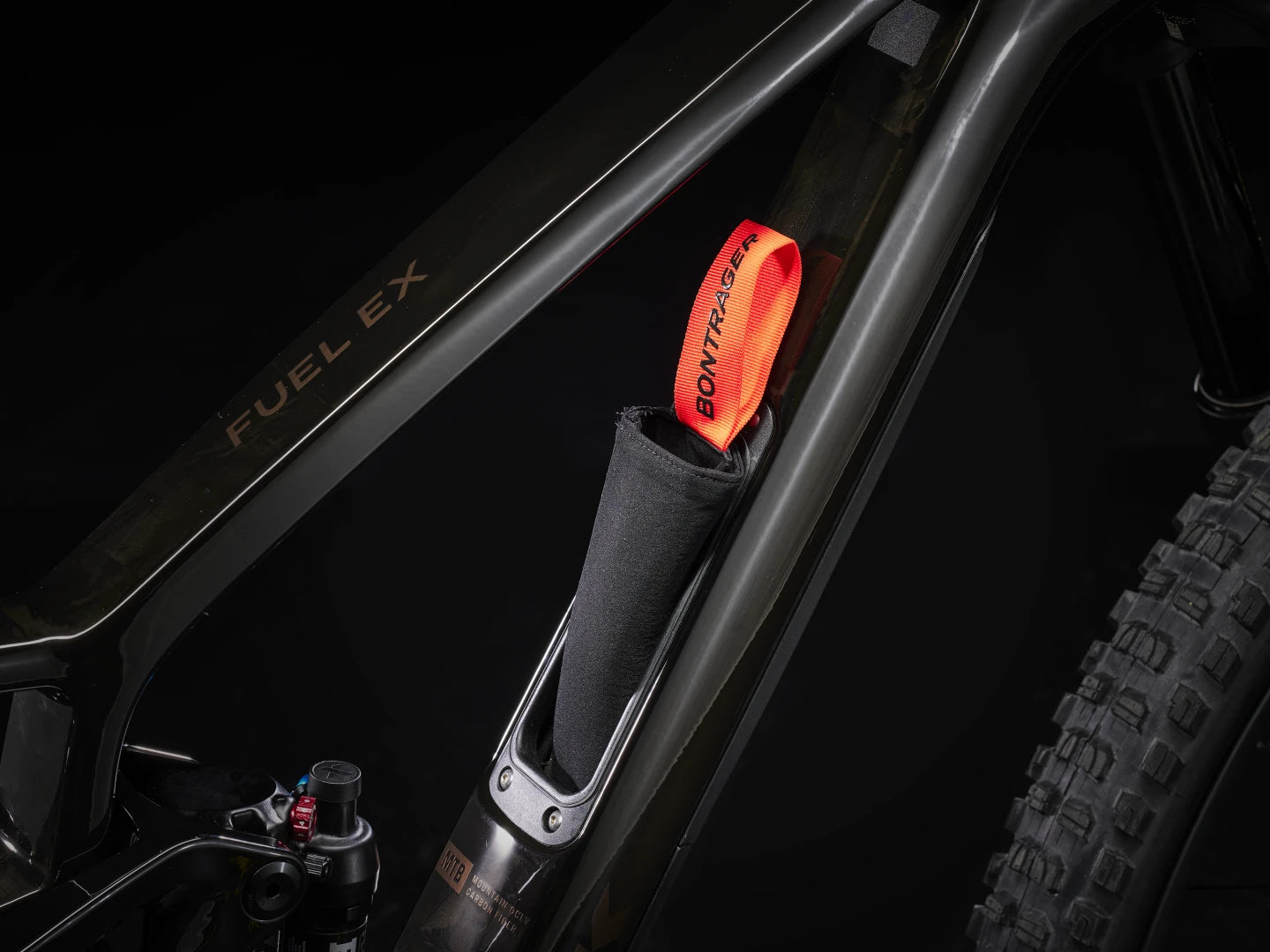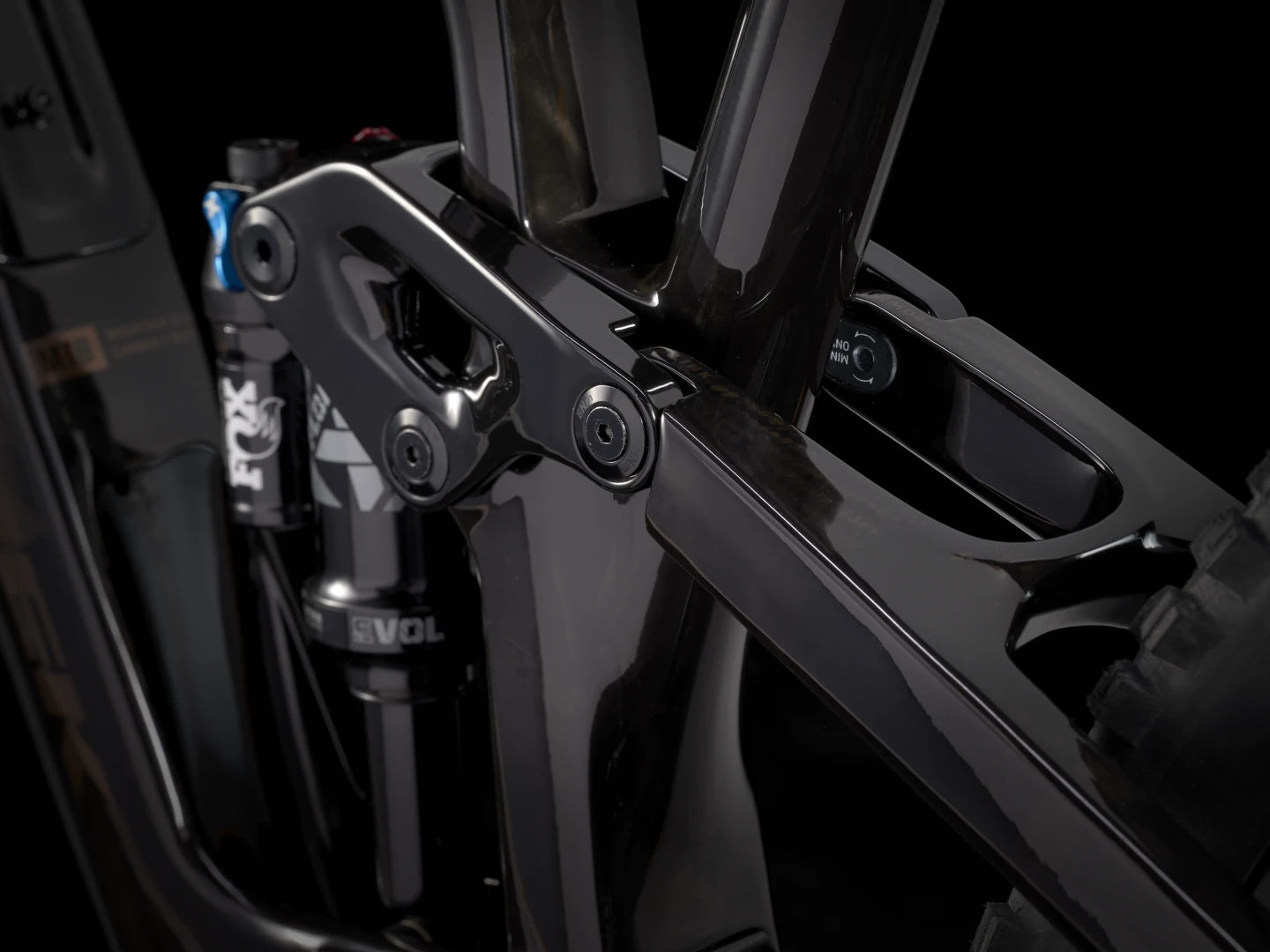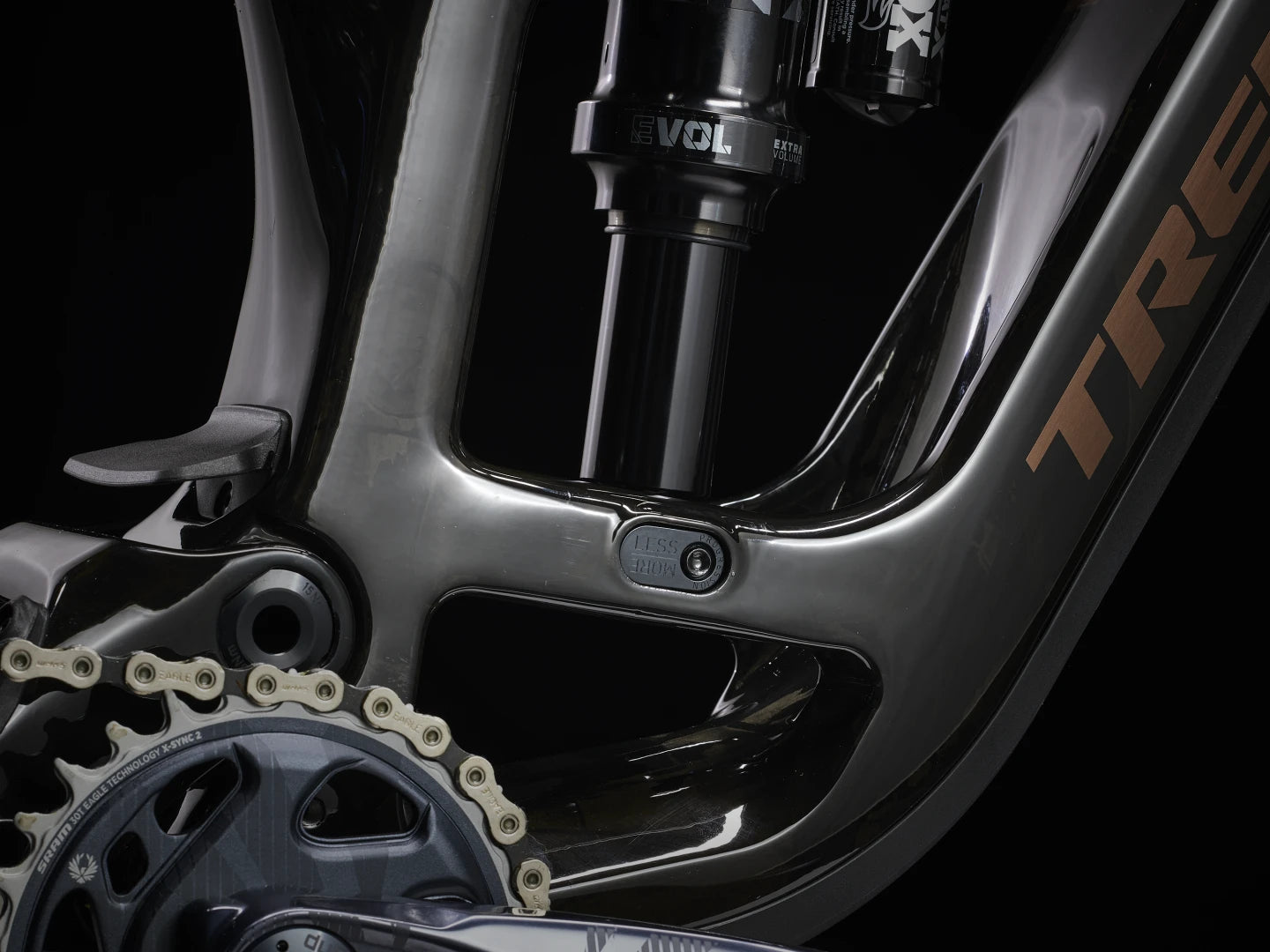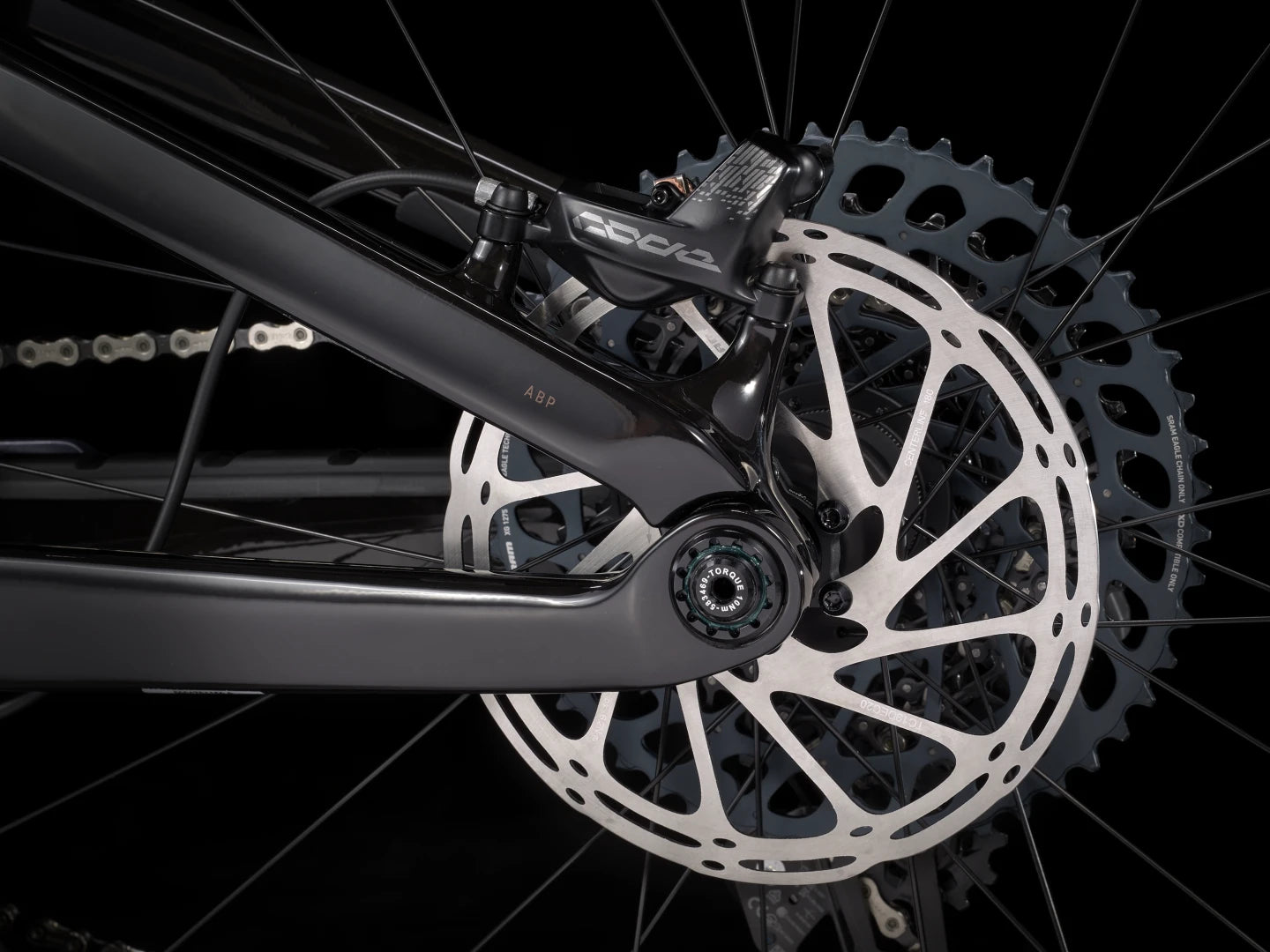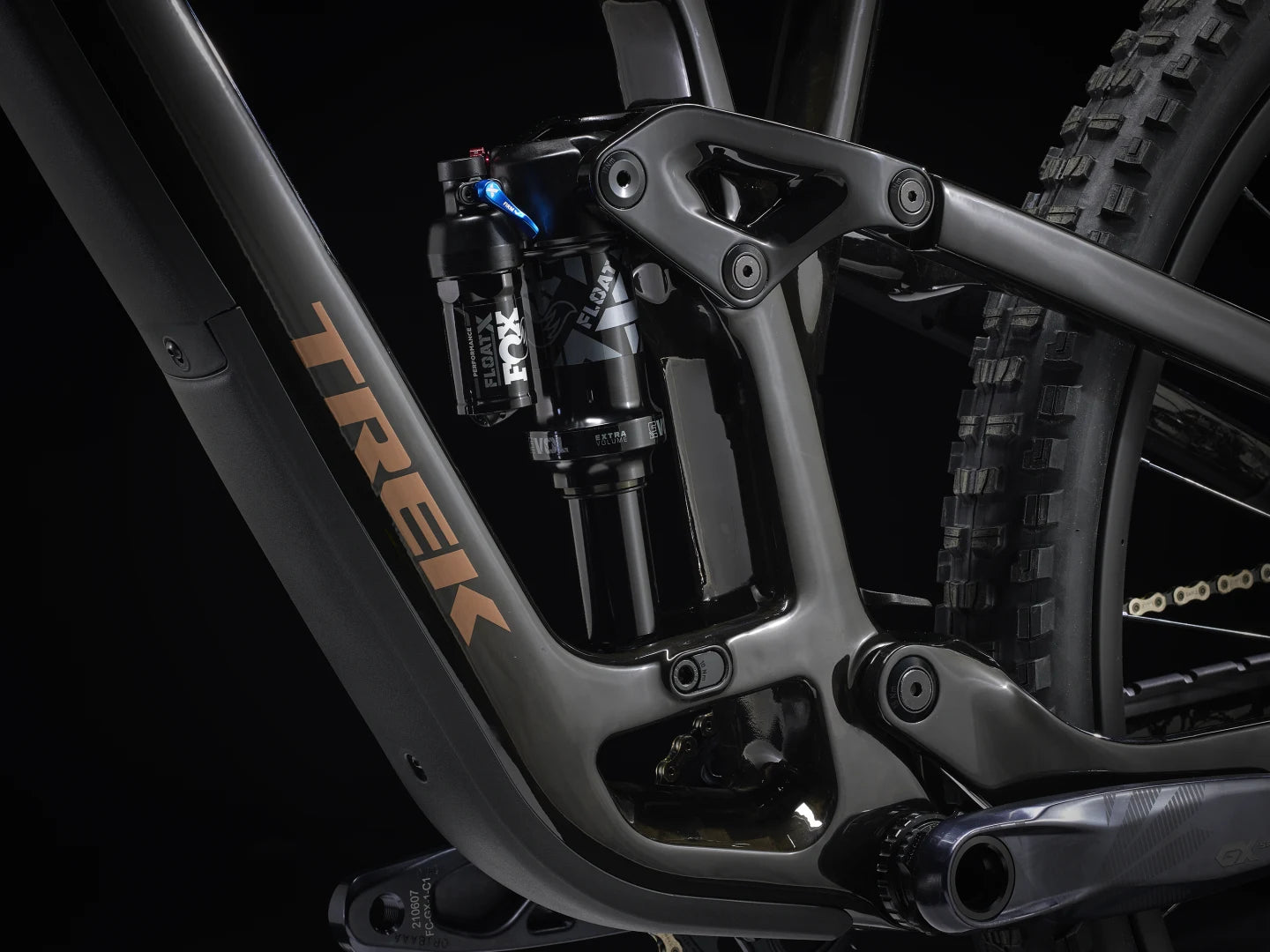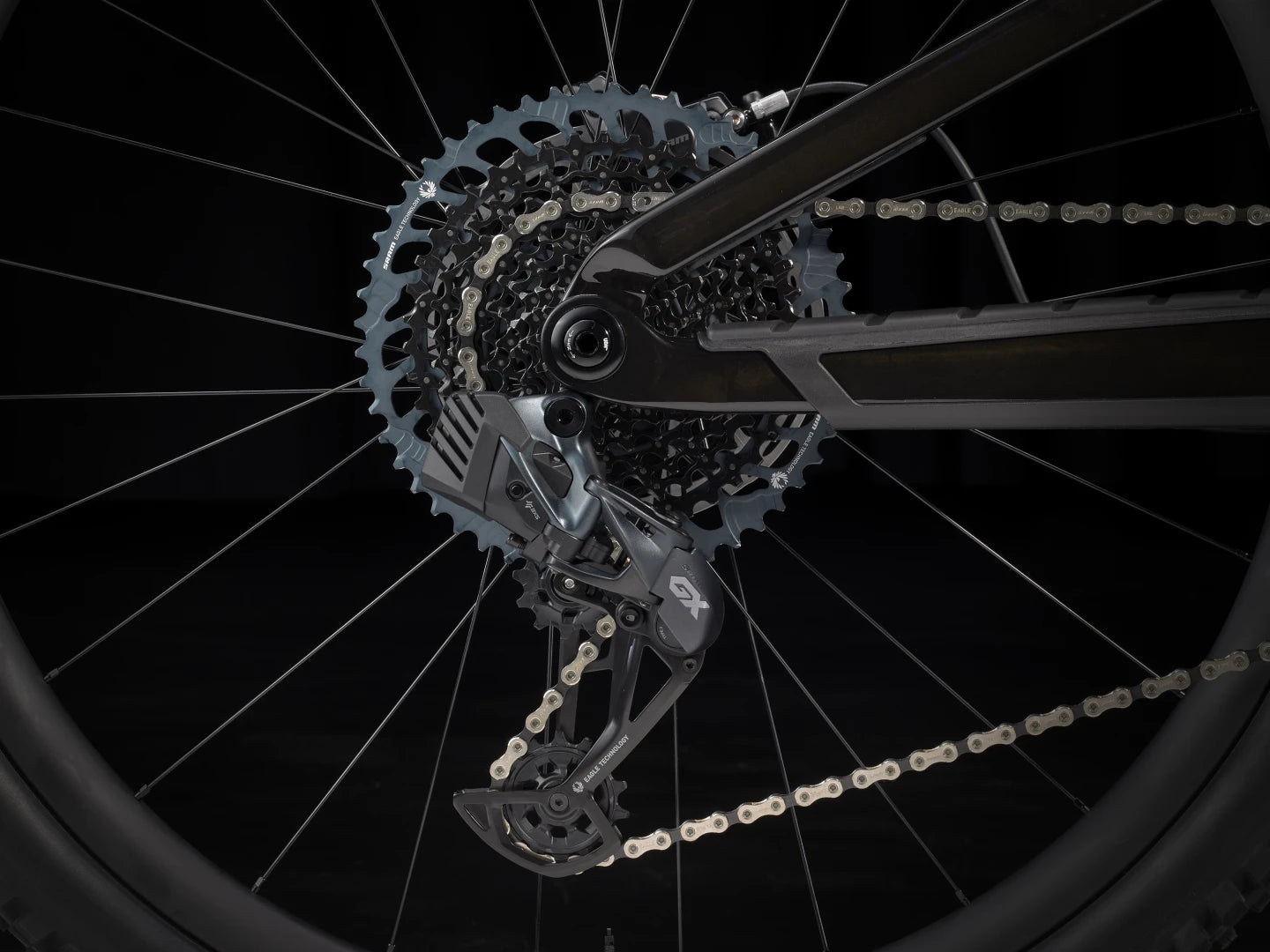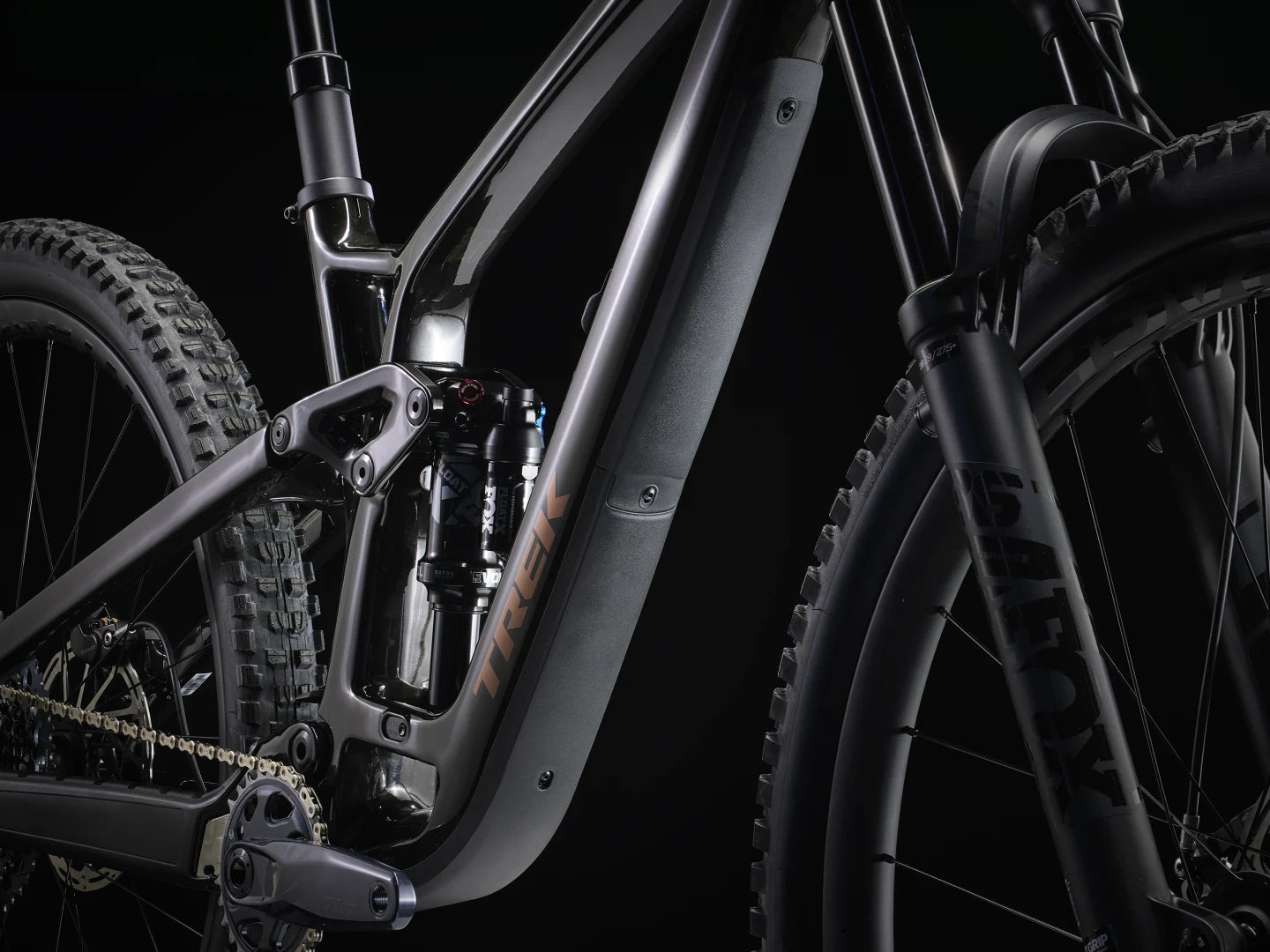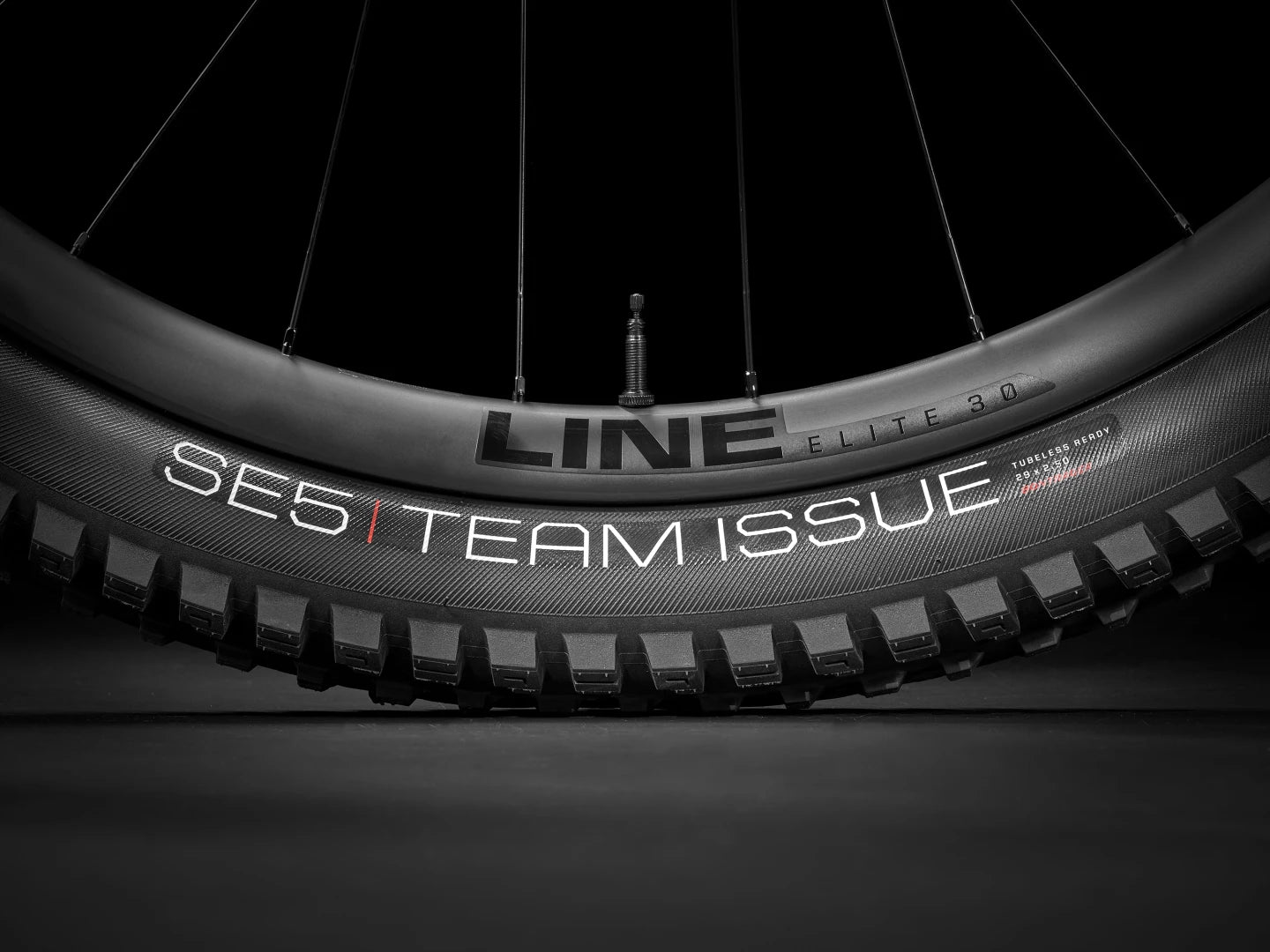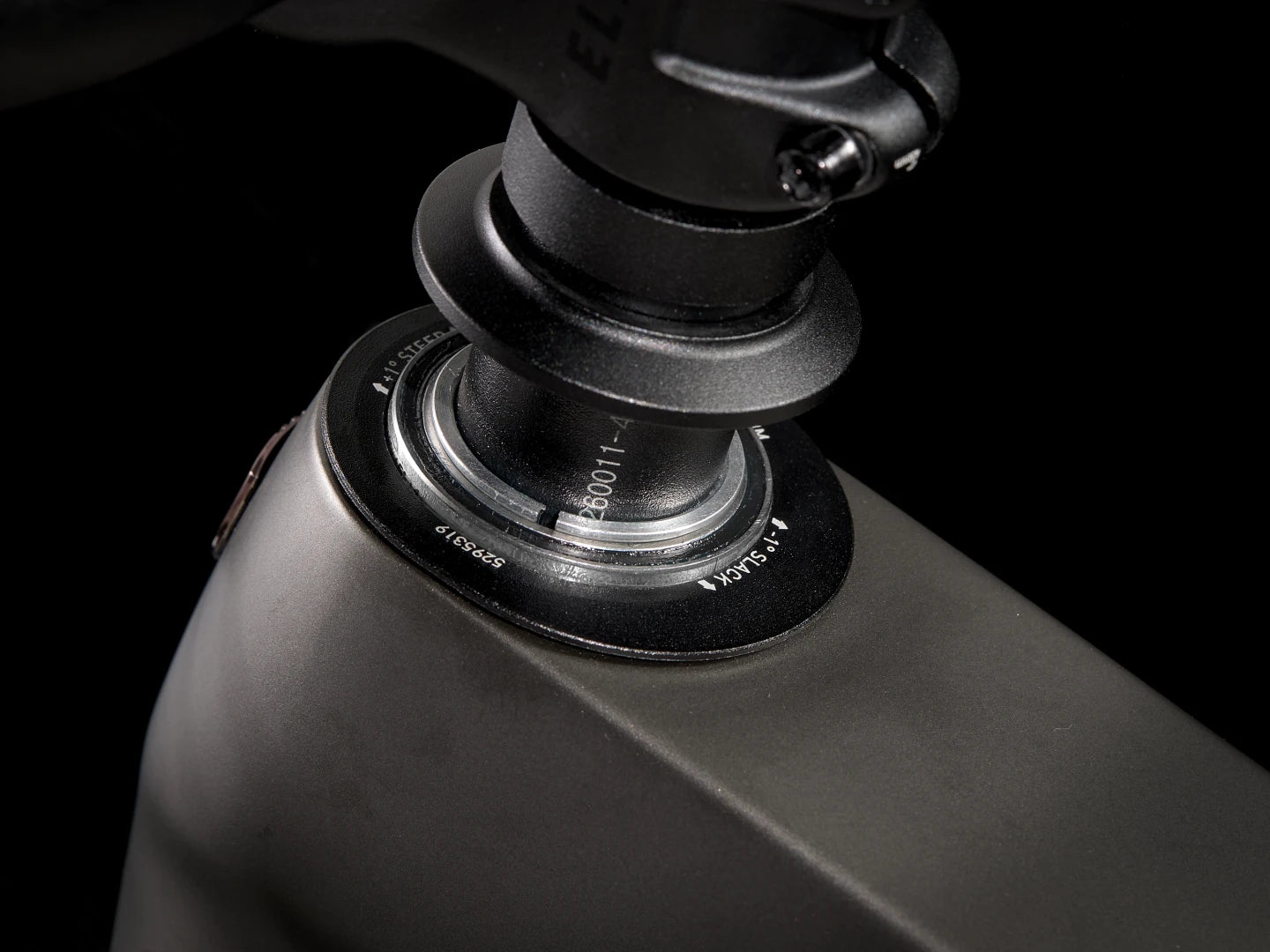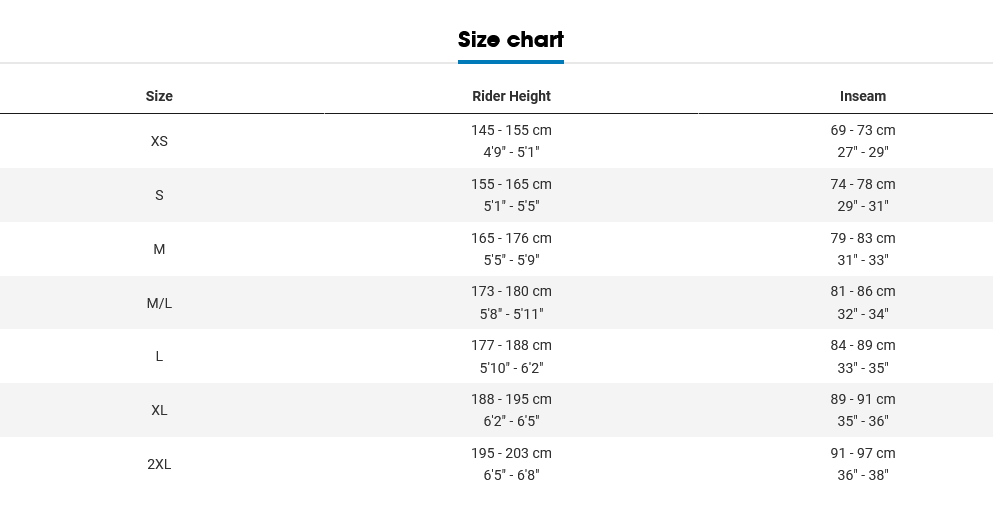Product Details
Product Details
Key Features
- Fox Rhythm 36 fork: 150mm Suspension with 36mm stanchions for greater steering precision
- Carbon fibre 140mm travel Frame with downtube storage: Progressive geometry built to tackle steep and gnarly descents and punchy climbs alike
- 12-Speed SRAM GX AXS Gears: SRAM's workhorse GX group set, with wireless AXS shifting
Full Specification
- Frame: OCLV Mountain Carbon, internal storage, angle-adjust headset, Mino Link adjustable geometry, adjustable leverage rate, guided internal routing, magnesium rocker link, 34.9 mm seat tube, ISCG 05, 55 mm chain line, BSA 73, downtube guard, shuttle guard, ABP, UDH, Boost148, 140 mm travel
- Rear Shock: Fox Performance Float X, 2-position damper, 185mm x 55mm
- Fork: Fox Performance 36, Float EVOL air spring, GRIP damper, tapered steerer, 44 mm offset, Boost110, 15 mm Kabolt axle, 150 mm travel
- Gear Shifters: SRAM GX Eagle AXS, 12-speed
- Chainset: SRAM GX Eagle, DUB MTB Wide, 30T, 55mm chainline, 170 length
- Rear Cassette: SRAM Eagle XG-1275, 10-52, 12-speed
- Chain: SRAM GX Eagle, 12-speed
- Front Derailleur: N/A
- Rear Derailleur: SRAM GX Eagle AXS
- Bottom Bracket: SRAM DUB MTB Wide, 73 m, BSA threaded
- Pedals: Not Included
- Rims: Bontrager Line Elite 30, OCLV Mountain Carbon, Tubeless Ready, 6-bolt, Boost110, 15mm thru axle
- Front Hub: Bontrager alloy, sealed bearing, alloy axle, 6-bolt, Boost110, 15 mm thru axle
- Rear Hub: Bontrager alloy, sealed bearing, 6-bolt, 108T Rapid Drive, SRAM XD driver, Boost148, 12 mm thru axle
- Tyres: Bontrager SE5 Team Issue, Tubeless Ready, Core Strength sidewalls, aramid bead, 120 tpi, 29x2.50" or 27.5x2.50"(Size small and Xsmall)
- Brakes: SRAM Code R 4-piston hydraulic disc, SRAM CenterLine, 6-bolt, round edge, 180/200 mm
- Handlebars: Bontrager RSL Integrated handlebar/stem, OCLV Carbon, 27.5 mm handlebar rise, 820 mm width, 0-degree stem rise, 35-45mm stem length
- Handlebar Grips: Bontrager XR Trail Elite, lock-on
- Headset: Integrated cartridge bearing, 1-1/8" top, 1.5" bottom, angle adjust cup compatible
- Saddle: Bontrager Arvada, austenite rails
- Seatpost: Bontrager line dropper 100-200 mm travel, internal routing, 34.9 mm
- Accessories: Bontrager Bits frame storage bag
- Weight: M – 14.15 kg/31.21 lb (with TLR sealant, no tubes)
We reserve the right to make changes to the product information contained on this site at any time without notice, including with respect to equipment, specifications, models, colours, materials and pricing. Due to supply chain issues, compatible parts may be substituted at any time without notice.
Bike and frame weights are based on pre-production painted frames at time of publication. Weights may vary in final production.
How to Build Your Bike
How to Build Your Bike
Aftercare
Aftercare
You Might Be Interested In
TREK FUEL EX 9.8 GX AXS GEN 6 MTB BIKE 2023 DEEP SMOKE
- SKU: 5276907
- EPOS Code:
- Here to help 6 days a week, online, on phone, and in store
- A true independent, family-owned business since 1907
- 10% Off accessories with every bike
Product Description
Product Description
Key Features
- Fox Rhythm 36 fork: 150mm Suspension with 36mm stanchions for greater steering precision
- Carbon fibre 140mm travel Frame with downtube storage: Progressive geometry built to tackle steep and gnarly descents and punchy climbs alike
- 12-Speed SRAM GX AXS Gears: SRAM's workhorse GX group set, with wireless AXS shifting
Full Specification
- Frame: OCLV Mountain Carbon, internal storage, angle-adjust headset, Mino Link adjustable geometry, adjustable leverage rate, guided internal routing, magnesium rocker link, 34.9 mm seat tube, ISCG 05, 55 mm chain line, BSA 73, downtube guard, shuttle guard, ABP, UDH, Boost148, 140 mm travel
- Rear Shock: Fox Performance Float X, 2-position damper, 185mm x 55mm
- Fork: Fox Performance 36, Float EVOL air spring, GRIP damper, tapered steerer, 44 mm offset, Boost110, 15 mm Kabolt axle, 150 mm travel
- Gear Shifters: SRAM GX Eagle AXS, 12-speed
- Chainset: SRAM GX Eagle, DUB MTB Wide, 30T, 55mm chainline, 170 length
- Rear Cassette: SRAM Eagle XG-1275, 10-52, 12-speed
- Chain: SRAM GX Eagle, 12-speed
- Front Derailleur: N/A
- Rear Derailleur: SRAM GX Eagle AXS
- Bottom Bracket: SRAM DUB MTB Wide, 73 m, BSA threaded
- Pedals: Not Included
- Rims: Bontrager Line Elite 30, OCLV Mountain Carbon, Tubeless Ready, 6-bolt, Boost110, 15mm thru axle
- Front Hub: Bontrager alloy, sealed bearing, alloy axle, 6-bolt, Boost110, 15 mm thru axle
- Rear Hub: Bontrager alloy, sealed bearing, 6-bolt, 108T Rapid Drive, SRAM XD driver, Boost148, 12 mm thru axle
- Tyres: Bontrager SE5 Team Issue, Tubeless Ready, Core Strength sidewalls, aramid bead, 120 tpi, 29x2.50" or 27.5x2.50"(Size small and Xsmall)
- Brakes: SRAM Code R 4-piston hydraulic disc, SRAM CenterLine, 6-bolt, round edge, 180/200 mm
- Handlebars: Bontrager RSL Integrated handlebar/stem, OCLV Carbon, 27.5 mm handlebar rise, 820 mm width, 0-degree stem rise, 35-45mm stem length
- Handlebar Grips: Bontrager XR Trail Elite, lock-on
- Headset: Integrated cartridge bearing, 1-1/8" top, 1.5" bottom, angle adjust cup compatible
- Saddle: Bontrager Arvada, austenite rails
- Seatpost: Bontrager line dropper 100-200 mm travel, internal routing, 34.9 mm
- Accessories: Bontrager Bits frame storage bag
- Weight: M – 14.15 kg/31.21 lb (with TLR sealant, no tubes)
We reserve the right to make changes to the product information contained on this site at any time without notice, including with respect to equipment, specifications, models, colours, materials and pricing. Due to supply chain issues, compatible parts may be substituted at any time without notice.
Bike and frame weights are based on pre-production painted frames at time of publication. Weights may vary in final production.
How to Build Your Bike
How to Build Your Bike
Aftercare
Aftercare
You Might Be Interested In
